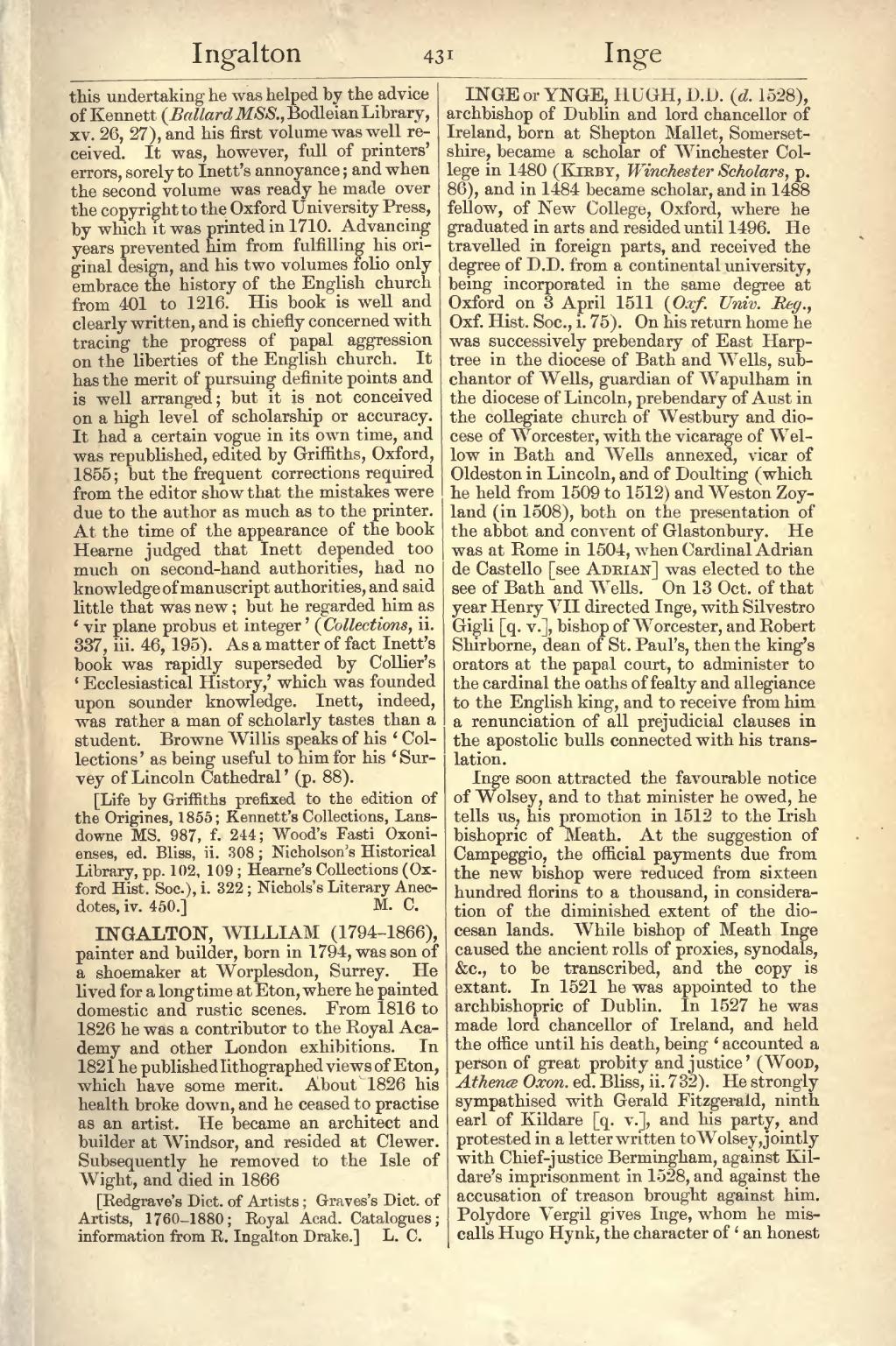this undertaking he was helped by the advice of Kennett (Ballard MSS., Bodleian Library, xv. 26, 27), and his first volume was well received. It was, however, full of printers' errors, sorely to Inett's annoyance; and when the second volume was ready he made over the copyright to the Oxford University Press, by which it was printed in 1710. Advancing years prevented him from fulfilling his original design, and his two volumes folio only embrace the history of the English church from 401 to 1216. His book is well and clearly written, and is chiefly concerned with tracing the progress of papal aggression on the liberties of the English church. It has the merit of pursuing definite points and is well arranged; but it is not conceived on a high level of scholarship or accuracy. It had a certain vogue in its own time, and was republished, edited by Griffiths, Oxford, 1855; but the frequent corrections required from the editor show that the mistakes were due to the author as much as to the printer. At the time of the appearance of the book Hearne judged that Inett depended too much on second-hand authorities, had no knowledge of manuscript authorities, and said little that was new; but he regarded him as `vir plane probus et integer' (Collections, ii. 337, iii. 46, 195). As a matter of fact Inett's book was rapidly superseded by Collier's 'Ecclesiastical History,' which was founded upon sounder knowledge. Inett, indeed, was rather a man of scholarly tastes than a student. Browne Willis speaks of his 'Collections' as being useful to him for his 'Survey of Lincoln Cathedral' (p. 88).
[Life by Griffiths prefixed to the edition of the Origines, 1855; Kennett's Collections, Lansdowne MS. 987, f. 244; Wood's Fasti Oxonienses, ed. Bliss, ii. 308; Nicholson's Historical Library, pp. 102, 109; Hearne's Collections (Oxford Hist. Soc.), i. 322; Nichols's Literary Anecdotes, iv. 450.]
INGALTON, WILLIAM (1794–1866), painter and builder, born in 1794, was son of a shoemaker at Worplesdon, Surrey. He lived for a longtime at Eton, where he painted domestic and rustic scenes. From 1816 to 1826 he was a contributor to the Royal Academy and other London exhibitions. In 1821 he published lithographed views of Eton, which have some merit. About 1826 his health broke down, and he ceased to practise as an artist. He became an architect and builder at Windsor, and resided at Clewer. Subsequently he removed to the Isle of Wight, and died in 1866
[Redgrave's Dict. of Artists; Graves's Dict. of Artists, 1760-1880; Royal Acad. Catalogues; information from R. Ingalton Drake.]
INGE or YNGE, HUGH, D.D. (d. 1528), archbishop of Dublin and lord chancellor of Ireland, born at Shepton Mallet, Somersetshire, became a scholar of Winchester College in 1480 (Kirby, Winchester Scholars, p. 86), and in 1484 became scholar, and in 1488 fellow, of New College, Oxford, where he graduated in arts and resided until 1496. He travelled in foreign parts, and received the degree of D.D. from a continental university,
being incorporated in the same degree at Oxford on 3 April 1511 (Oxf. Univ. Reg., Oxf. Hist. Soc., i. 75). On his return home he was successively prebendary of East Harptree in the diocese of Bath and Wells, subchantor of Wells, guardian of Wapulham in the diocese of Lincoln, prebendary of Aust in the collegiate church of Westbury and diocese of Worcester, with the vicarage of Wellow in Bath and Wells annexed, vicar of Oldeston in Lincoln, and of Doulting (which he held from 1509 to 1512) and Weston Zoyland (in 1508), both on the presentation of the abbot and convent of Glastonbury. He was at Rome in 1504, when Cardinal Adrian de Castello [see Adrian] was elected to the see of Bath and Wells. On 13 Oct. of that year Henry VII directed Inge, with Silvestro Gigli [q. v.], bishop of Worcester, and Robert Shirborne, dean of St. Paul's, then the king's orators at the papal court, to administer to the cardinal the oaths of fealty and allegiance to the English king, and to receive from him a renunciation of all prejudicial clauses in the apostolic bulls connected with his translation.
Inge soon attracted the favourable notice of Wolsey, and to that minister he owed, he tells us, his promotion in 1512 to the Irish bishopric of Meath. At the suggestion of Campeggio, the official payments due from the new bishop were reduced from sixteen hundred florins to a thousand, in consideration of the diminished extent of the diocesan lands. While bishop of Meath Inge caused the ancient rolls of proxies, synodals, &c., to be transcribed, and the copy is extant. In 1521 he was appointed to the archbishopric of Dublin. In 1527 he was made lord chancellor of Ireland, and held the office until his death, being 'accounted a person of great probity and justice' (Wood, Athenæ Oxon. ed. Bliss, ii. 732). He strongly sympathised with Gerald Fitzgerald, ninth earl of Kildare [q. v.], and his party, and protested in a letter written to Wolsey Jointly with Chief-justice Bermingham, against Kildare's imprisonment in 1528, and against the accusation of treason brought against him. Polydore Vergil gives Inge, whom he miscalls Hugo Hynk, the character of 'an honest
